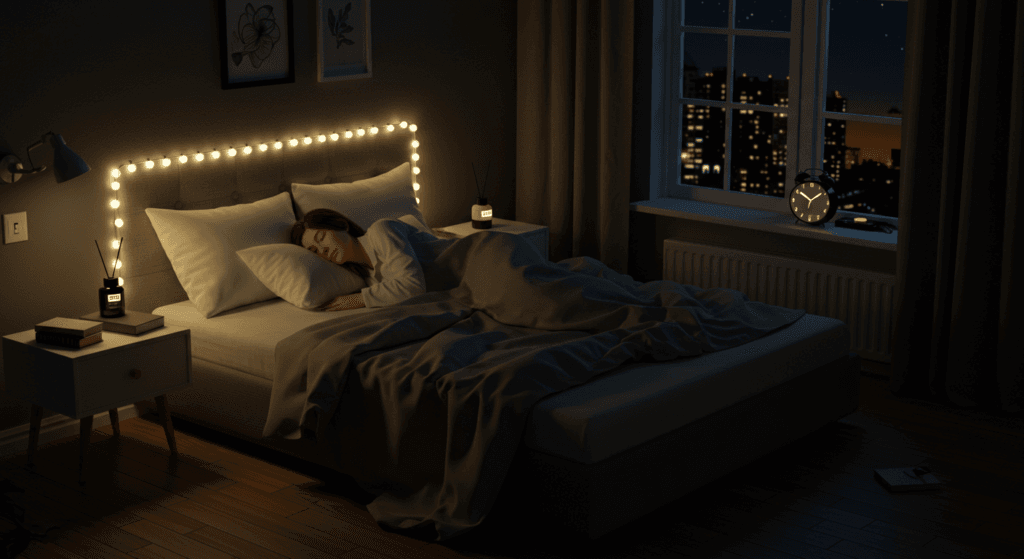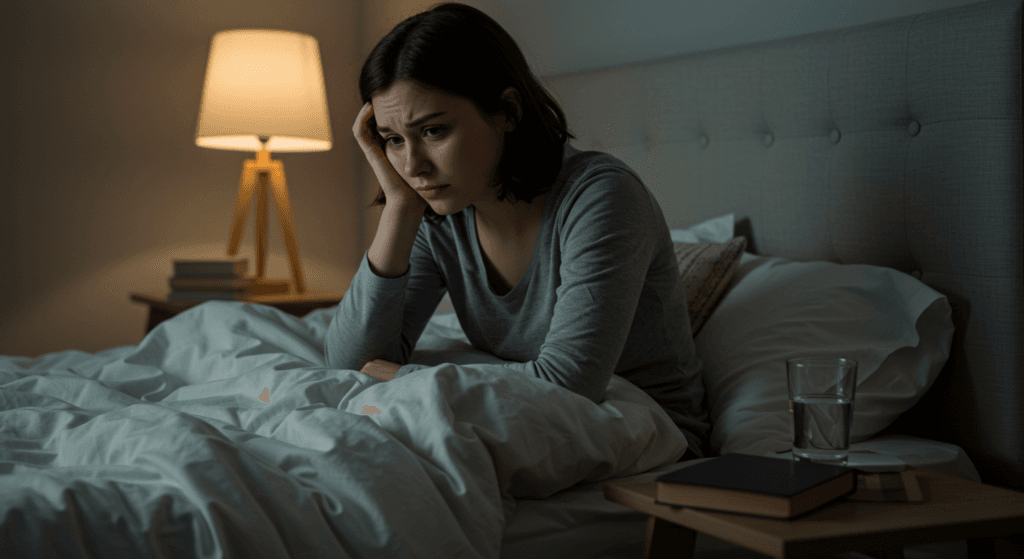
Ever counted 1,000 sheep and still felt wide awake? You’re not alone. Roughly 70 million folks in the U.S. wrestle with sleep disorders nightly, turning bedtime into a nightmare. But here’s the kicker: you might be sabotaging your sleep without even knowing it. In this guide, you’ll discover:
- A checklist of symptoms to help you identify your sleep disorder.
- The #1 mistake 90% of people make before bed (hint: it’s not caffeine).
- A military technique to fall asleep fast.
Ready to wake up refreshed? Let’s dive in!
Sleep Disorders 101: Is Your Body Sending SOS Signals?
Sleep Disorders Symptoms (The Silent Red Flags)
Your body whispers before it screams. These lesser-known symptoms often get ignored:
- “Micro-sleeps” (zoning out during meetings or TV).
- Nighttime “mouth breathing” (hello, morning dragon breath!).
- Nighttime leg restlessness – that strange, irresistible need to keep moving your legs when trying to sleep.
Pro Tip: Your body has its own perfect alarm clock – when you get enough quality sleep, you’ll often wake up naturally right when you need to.
Sleep Disorders Decoded: Which One Is Sabotaging Your Zzz’s?
Think all sleep problems are the same? Think again. Your 3 AM zombie mode could be one of these 5 stealthy sleep thieves – and each needs a different knockout punch.
1. Insomnia (The Nighttime Overthinker)
- Stats: 1 in 3 adults battles this.
- Your Signs: Tired but wired” at bedtime, mind racing in an unstoppable loop.
- Natural Fix:
- “Brain dump” journaling before bed (write worries away).
- Chamomile + honey tea (the OG sleepytime combo).
2. Sleep Apnea (The Silent Choker)
- Stats: 22 million Americans gasp for air nightly.
- Your Signs: Waking up with a Sahara-dry mouth, partner complains about snoring.
- Natural Fix:
- Tennis ball trick: Sew one into your PJ back to force side-sleeping.
- Sing 10 mins daily (strengthens throat muscles – no joke!).
3. Restless Legs (The Midnight Dancer)
- Stats: 1 in 10 adults has these “creepy-crawly” legs.
- Your Signs: That irresistible urge to kick like a Rockette at bedtime.
- Natural Fix:
- Pillow between knees (aligns hips, stops nerve pinching).
- Epsom salt foot soak (magnesium absorbs through skin).
4. Narcolepsy (The Random Nap Attack)
- Stats: Rare but brutal (1 in 2,000 people).
- Your Signs: Face-planting into lunch, dream-like hallucinations when waking.
- Natural Fix:
- 15-min “power nap” schedule (2 PM sharp).
- High-protein breakfast (stabilizes energy crashes).
5. Circadian Rhythm Disorder (The Night Owl Trap)
- Stats: 1 in 20 people’s internal clock runs on “vampire time” – and for 15% of teens, it’s delayed sleep phase disorder.
- Your Signs:
- Most productive at 2 AM (your “natural noon”)
- Mornings feel like torture (even after “enough” sleep)
- Social jetlag (constantly tired on “normal” schedules)
- Natural Fix:
- 10 mins of sunrise simulator light at 7 AM (resets brain’s clock)
- No screens after 8 PM (blue light = vampire fuel)
- Low-dose melatonin (0.5mg) 5 hours before target bedtime
6. REM Sleep Behavior Disorder (The Dream Fighter)
- Stats: Affects 1% of adults, mostly men over 50.
- Your Signs:
- Physically acting out dreams (punching, kicking, yelling)
- Vivid recall of “action-packed” dreams
- Unlike sleepwalking – happens during REM sleep
- Natural Fix:
- Bedroom safety proofing (remove sharp objects)
- Melatonin supplements (under doctor supervision)
Sleep Disorders Symptom Checklist (Score Yourself!)
Grab a pen and check any that apply:
| Symptom | Mild (1pt) | Severe (3pts) |
|---|---|---|
| Takes >30 mins to fall asleep | 3+ nights/week | Every night |
| Wake up gasping for air | Rarely | 3+ times/week |
| Daytime fatigue | Occasional naps | Can’t function without coffee |
If you’re on a mobile, you might have to swipe left.
Score Key:
- 1-3pts: Mild (fix with our hacks below).
- 4-6pts: Moderate (try our 2-week sleep reset).
- 7+pts: Severe (see a doc + use our emergency tips).
The Insomnia Severity Index: Where Do You Stand?
Can’t tell if your sleepless nights are just annoying or clinically serious? The Insomnia Severity Index (ISI) – a test used by sleep doctors worldwide – gives you a clear answer in just 7 questions. Score yourself below to discover if you’re dealing with mild restlessness or full-blown insomnia (and exactly what to do about it). Your sleep transformation starts with this 2-minute reality check!
This test can help you identify your risk level:
| Question | Your Score (0-4) |
|---|---|
| How satisfied are you with your sleep? | 0 (Very) → 4 (Not at all) |
| How noticeable is your tiredness to others? | 0 (Not at all) → 4 (Extremely) |
Results:
- 0-7: Normal sleeper (lucky you!).
- 8-14: Mild insomnia (try our 5-step fix).
- 15+: Clinical insomnia (act now!).
Fun Fact: People with scores >15 are 5x more likely to develop depression.
5 Natural Hacks to Beat Sleep Disorders (Works in 48h!)
1. The “10-3-2-1-0” Rule (No Willpower Needed!)
It mimics a rocket launch sequence – but this is actually your science-backed wind-down ritual for sleeping disorders. The method automatically counters the top 5 sleep disruptors (no willpower required), and yes – it even works if you’re glued to evening screens.
- 10h before bed: No more caffeine.
- 3h before: Stop eating (digestion = enemy of deep sleep).
- 2h before: Power down your work mode with a relaxing transition routine – your mind craves this buffer zone before sleep
- 1h before: Screens OFF (blue light = melatonin killer).
- 0: The number of times you’ll hit snooze if you do this right.
2. Military Sleep Method (Fall Asleep in 120 Seconds?)
Famous as the ‘Military Sleep Method,’ this trick helps your body unwind fast—often in minutes. The concept? Creating physical signals that tell your brain it’s time to power down!
- Completely relax your face muscles (yes, even your tongue).
- Drop those shoulders and exhale deeply.
- Imagine: You know that feeling when you’re in a hammock? Palm leaves shading your face, that gentle rock making your eyelids grow heavy…
3. The “Bedroom Cave” Setup (Science-Backed!)
Bed feeling like a layover spot rather than a deep-sleep den? Transform it into a prehistoric cave—the environment your DNA still associates with rest. Light, temperature, and noise affect your sleep quality!
- Pitch black (cover LED lights with electrical tape).
- Cool (65°F) – like sleeping under a waterfall.
- Quiet (white noise machines work wonders for masking disturbances)
4. The “4-7-8” Breathing Trick (Instant Calm!)
This powerful breathing method naturally reduces the heart rate – perfect if you wake up at 3am with a racing heart or to relieve anxiety without the need for medication.
- Inhale for 4 seconds (fill your belly).
- Hold for 7 seconds (quiet the mind).
- Exhale for 8 seconds (release tension).
Why it works: Here’s the cool part: When you do this, your sympathetic nervous system gets the memo to shift from ‘alert’ to ‘ahhh.’ Heart rate? Slows. Muscles? Unkink. It’s biology’s own sleep hack.
5. Magnesium Spray (The “Sleep Mineral” Shortcut!)
Pílulas de magnésio são lentas e mal absorvidas. Mas passar esse spray nos pés antes de dormir? Age como um ‘relaxante muscular’ natural em 15 minutos – perfeito para pernas inquietas ou músculos tensionados por stress!
- Spritz magnesium oil on feet before bed.
- Absorbs faster than pills → relaxes muscles in 15 minutes.
Pro Tip: “Mix with lavender oil for a double sleep punch!”
FAQ
Key Takeaways
- You’re not ‘terrible at sleep’—Your bedroom should feel like a cave (cold, dark, and phone-free).
- Optimize your sleep space like a hibernation den: chilly temperatures, zero light pollution, and no digital devices.
- The military method can knock you out faster than melatonin.
If you found this article useful, share it with a friend and subscribe to our free newsletter at the bottom of the page so I can send you more tips on sleep health.


